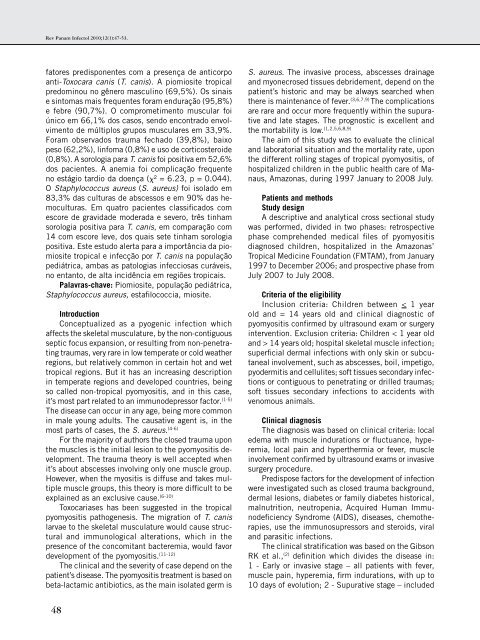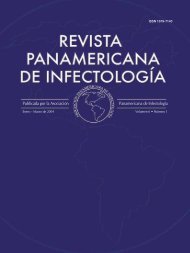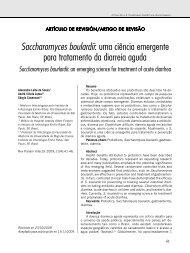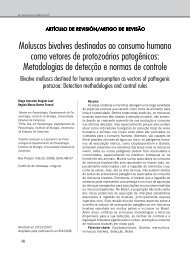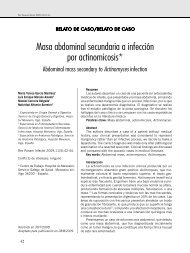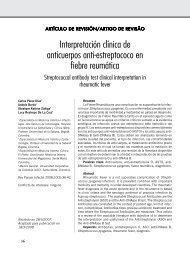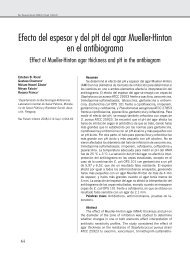Clinical-laboratorial characteristics Toxocara canis serology and ...
Clinical-laboratorial characteristics Toxocara canis serology and ...
Clinical-laboratorial characteristics Toxocara canis serology and ...
You also want an ePaper? Increase the reach of your titles
YUMPU automatically turns print PDFs into web optimized ePapers that Google loves.
Rev Panam Infectol 2010;12(1):47-53.<br />
fatores predisponentes com a presença de anticorpo<br />
anti-<strong>Toxocara</strong> <strong>canis</strong> (T. <strong>canis</strong>). A piomiosite tropical<br />
predominou no gênero masculino (69,5%). Os sinais<br />
e sintomas mais frequentes foram enduração (95,8%)<br />
e febre (90,7%). O comprometimento muscular foi<br />
único em 66,1% dos casos, sendo encontrado envolvimento<br />
de múltiplos grupos musculares em 33,9%.<br />
Foram observados trauma fechado (39,8%), baixo<br />
peso (62,2%), linfoma (0,8%) e uso de corticosteroide<br />
(0,8%). A sorologia para T. <strong>canis</strong> foi positiva em 52,6%<br />
dos pacientes. A anemia foi complicação frequente<br />
no estágio tardio da doença (x² = 6.23, p = 0.044).<br />
O Staphylococcus aureus (S. aureus) foi isolado em<br />
83,3% das culturas de abscessos e em 90% das hemoculturas.<br />
Em quatro pacientes classificados com<br />
escore de gravidade moderada e severo, três tinham<br />
sorologia positiva para T. <strong>canis</strong>, em comparação com<br />
14 com escore leve, dos quais sete tinham sorologia<br />
positiva. Este estudo alerta para a importância da piomiosite<br />
tropical e infecção por T. <strong>canis</strong> na população<br />
pediátrica, ambas as patologias infecciosas curáveis,<br />
no entanto, de alta incidência em regiões tropicais.<br />
Palavras-chave: Piomiosite, população pediátrica,<br />
Staphylococcus aureus, estafilococcia, miosite.<br />
Introduction<br />
Conceptualized as a pyogenic infection which<br />
affects the skeletal musculature, by the non-contiguous<br />
septic focus expansion, or resulting from non-penetrating<br />
traumas, very rare in low temperate or cold weather<br />
regions, but relatively common in certain hot <strong>and</strong> wet<br />
tropical regions. But it has an increasing description<br />
in temperate regions <strong>and</strong> developed countries, being<br />
so called non-tropical pyomyositis, <strong>and</strong> in this case,<br />
it’s most part related to an immunodepressor factor. (1-5)<br />
The disease can occur in any age, being more common<br />
in male young adults. The causative agent is, in the<br />
most parts of cases, the S. aureus. (4-6)<br />
For the majority of authors the closed trauma upon<br />
the muscles is the initial lesion to the pyomyositis development.<br />
The trauma theory is well accepted when<br />
it’s about abscesses involving only one muscle group.<br />
However, when the myositis is diffuse <strong>and</strong> takes multiple<br />
muscle groups, this theory is more difficult to be<br />
explained as an exclusive cause. (6-10)<br />
Toxocariases has been suggested in the tropical<br />
pyomyositis pathogenesis. The migration of T. <strong>canis</strong><br />
larvae to the skeletal musculature would cause structural<br />
<strong>and</strong> immunological alterations, which in the<br />
presence of the concomitant bacteremia, would favor<br />
development of the pyomyositis. (11-12)<br />
The clinical <strong>and</strong> the severity of case depend on the<br />
patient’s disease. The pyomyositis treatment is based on<br />
beta-lactamic antibiotics, as the main isolated germ is<br />
48<br />
S. aureus. The invasive process, abscesses drainage<br />
<strong>and</strong> myonecrosed tissues debridement, depend on the<br />
patient’s historic <strong>and</strong> may be always searched when<br />
there is maintenance of fever. (3,6,7,9) The complications<br />
are rare <strong>and</strong> occur more frequently within the supurative<br />
<strong>and</strong> late stages. The prognostic is excellent <strong>and</strong><br />
the mortability is low. (1,2,5,6,8,9)<br />
The aim of this study was to evaluate the clinical<br />
<strong>and</strong> <strong>laboratorial</strong> situation <strong>and</strong> the mortality rate, upon<br />
the different rolling stages of tropical pyomyositis, of<br />
hospitalized children in the public health care of Manaus,<br />
Amazonas, during 1997 January to 2008 July.<br />
Patients <strong>and</strong> methods<br />
Study design<br />
A descriptive <strong>and</strong> analytical cross sectional study<br />
was performed, divided in two phases: retrospective<br />
phase comprehended medical files of pyomyositis<br />
diagnosed children, hospitalized in the Amazonas’<br />
Tropical Medicine Foundation (FMTAM), from January<br />
1997 to December 2006; <strong>and</strong> prospective phase from<br />
July 2007 to July 2008.<br />
Criteria of the eligibility<br />
Inclusion criteria: Children between < 1 year<br />
old <strong>and</strong> = 14 years old <strong>and</strong> clinical diagnostic of<br />
pyomyositis confirmed by ultrasound exam or surgery<br />
intervention. Exclusion criteria: Children < 1 year old<br />
<strong>and</strong> > 14 years old; hospital skeletal muscle infection;<br />
superficial dermal infections with only skin or subcutaneal<br />
involvement, such as abscesses, boil, impetigo,<br />
pyodermitis <strong>and</strong> cellulites; soft tissues secondary infections<br />
or contiguous to penetrating or drilled traumas;<br />
soft tissues secondary infections to accidents with<br />
venomous animals.<br />
<strong>Clinical</strong> diagnosis<br />
The diagnosis was based on clinical criteria: local<br />
edema with muscle indurations or fluctuance, hyperemia,<br />
local pain <strong>and</strong> hyperthermia or fever, muscle<br />
involvement confirmed by ultrasound exams or invasive<br />
surgery procedure.<br />
Predispose factors for the development of infection<br />
were investigated such as closed trauma background,<br />
dermal lesions, diabetes or family diabetes historical,<br />
malnutrition, neutropenia, Acquired Human Immunodeficiency<br />
Syndrome (AIDS), diseases, chemotherapies,<br />
use the immunosupressors <strong>and</strong> steroids, viral<br />
<strong>and</strong> parasitic infections.<br />
The clinical stratification was based on the Gibson<br />
RK et al., (2) definition which divides the disease in:<br />
1 - Early or invasive stage – all patients with fever,<br />
muscle pain, hyperemia, firm indurations, with up to<br />
10 days of evolution; 2 - Supurative stage – included


